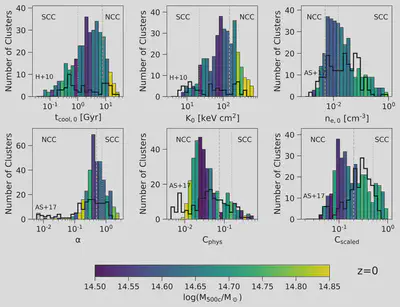Cool-core galaxy cluster
 Cores of galaxy clusters in TNG-Cluster
Cores of galaxy clusters in TNG-ClusterThe gas of the intracluster medium (ICM) is subject to a rich interplay between different physical processes. On the one hand it is heated by mechanisms including hydrodynamical shocks, feedback from supermassive black holes (SMBHs) i.e. active galactic nuclei, mergers, and many more. The thermal energy content of the ICM is lost due to radiative cooling, primarily via free-free bremsstrahlung. However, this cooling is only effective when the gas is sufficiently dense, which is true in the cores of some, but not all, clusters. In particular, X-ray observations of the ICM reveal that the central cooling time can be short compared to the Hubble time. This implies that the ICM can rapidly cool down and form a so-called ‘cool core’, or a cool-core (CC) cluster. On the other hand, some clusters do not appear to have such cool cores, and these are labeled as non-cool-core (NCC) clusters.

In my ongoing project, I delve into the distinctive properties of clusters with and without cool cores. Our goal is to discern how core properties in a large sample of simulated galaxy clusters correlate with cluster mass and redshift. Additionally, we explore the internal (radial) structure of these clusters. The overarching aim is to ascertain whether clusters with cool cores and those without represent discrete classes or merely extremes within a continuous spectrum.

However, our inquiry extends beyond statistical properties; we want to develop understanding of the transformative mechanisms between cool-core and non-cool-core clusters. What events lead to the transition from a cool-core to a non-cool-core cluster? Do we find in our sample also clusters that transiotion from a NCC to a CC?
For our study we analyze the TNG-Cluster simulation, which is well-suited as it combines a large sample of massive galaxy clusters with an outstanding resolution.


